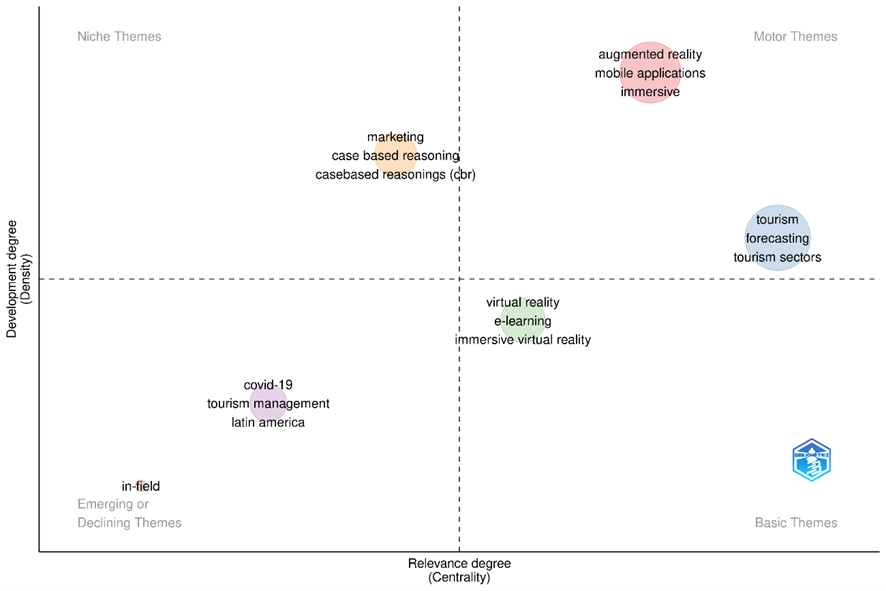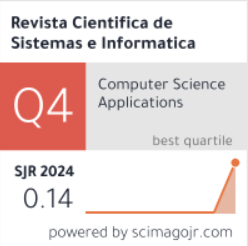Emerging technologies in the Peruvian tourism sector: a bibliometric analysis and perspectives on digital innovation
DOI:
https://doi.org/10.51252/rcsi.v5i2.929Keywords:
artificial intelligence, digital transformation, digital tourism, user experience, virtual realityAbstract
Tourism, as one of Peru's most dynamic economic sectors, faces the challenge of adapting to technological transformations that are redefining the way we travel, manage destinations, and generate value. In this context, emerging technologies such as artificial intelligence, augmented reality, big data, and the Internet of Things are positioned as tools to drive digital innovation in the sector. The objective of this study was to analyze scientific production on emerging technologies applied to Peruvian tourism using a bibliometric approach. The methodology was based on the analysis of 68 scientific articles extracted from the Scopus database, using a search string in English and filtering by affiliation with Peruvian institutions. Bibliometric indicators such as annual production, most productive sources, leading institutions, keywords, collaborative networks, and thematic analysis were applied. The results showed sustained growth in research, with a greater presence of regional universities and a strong connection with technological areas. The conclusion is that there is an expanding academic ecosystem, with practical implications for public policymaking, digital capacity building, and the design of smart tourism destinations in Peru.
Downloads
References
Aria, M., & Cuccurullo, C. (2017). bibliometrix : An R-tool for comprehensive science mapping analysis. Journal of Informetrics, 11(4), 959–975. https://doi.org/10.1016/j.joi.2017.08.007
Arroyo-Solórzano, M., & Rojas-Prendas, L. (2021). Ecotourism potential in Protected Natural Areas. Case: Tirimbina Biological Reserve (RBT), Sarapiquí, Province of Heredia, Costa Rica. Revista Geográfica de América Central, 1(66), 317–342. https://doi.org/10.15359/rgac.66-1.11
Bekele, H., & Raj, S. (2025). Digitalization and digital transformation in the tourism industry: a bibliometric review and research agenda. Tourism Review, 80(4), 894–913. https://doi.org/10.1108/TR-07-2023-0509
Bravo, J., Alarcón, R., Valdivia, C., & Serquén, O. (2023). Application of Machine Learning Techniques to Predict Visitors to the Tourist Attractions of the Moche Route in Peru. Sustainability, 15(11), 8967. https://doi.org/10.3390/su15118967
Castillo Botetano, F., & Salcedo, N. U. (2022). ViveChachapoyas.Com: Encouragement of Sustainable and Responsible Consumption of Community Rural Tourism Through Digital Transformation. In Socially Responsible Consumption and Marketing in Practice (pp. 201–238). Springer Nature Singapore. https://doi.org/10.1007/978-981-16-6433-5_14
Cayahuallpa-Paquirachi, C., Pacheco, A., & Uribe-Hernandez, Y. (2024). Transforming the tourism experience: Virtual Reality for customer loyalty in the tourism industry. F1000Research, 13, 302. https://doi.org/10.12688/f1000research.146072.1
Cheng, X., Xue, T., Yang, B., & Ma, B. (2023). A digital transformation approach in hospitality and tourism research. International Journal of Contemporary Hospitality Management, 35(8), 2944–2967. https://doi.org/10.1108/IJCHM-06-2022-0679
Cotrina-Trigozo, T. (2023). Tendencia potencial de la demanda del desarrollo turístico en la provincia de Lamas, región San Martín. Revista Amazónica de Ciencias Económicas, 2(1), e482. https://doi.org/10.51252/race.v2i1.482
Cotrina-Trigozo, T., Horna-Rodríguez, R., & Flores-Pinedo, C. (2024). Ecoturismo, alternativa de desarrollo socioeconómico en la comunidad nativa de Yurilamas en la cuenca del Alto Shanusi. Revista Amazónica de Ciencias Económicas, 3(1), e662. https://revistas.unsm.edu.pe/index.php/race/article/view/662
Fernández-Bedoya, V. H., Ruiz-Palacios, M. A., Meneses-La-Riva, M. E., & Suyo-Vega, J. A. (2025). Tourism Entrepreneurship in Latin America: A Systematic Review of Challenges, Strategies, and Post-COVID-19 Perspectives. Sustainability, 17(3), 989. https://doi.org/10.3390/su17030989
Fernández Cueria, N., Pérez Ricardo, E. del C., Medina Labrada, J. R., Coronado Provance, K. Z., & Feria Velázquez, F. F. (2022). Digital marketing management in tourist organizations. Visión de Futuro, 26(2), 211–226. https://doi.org/10.36995/j.visiondefuturo.2022.26.02.006.en
Filocamo, F., Di Paola, G., Mastrobuono, L., & Rosskopf, C. M. (2020). MoGeo, a Mobile Application to Promote Geotourism in Molise Region (Southern Italy). Resources, 9(3), 31. https://doi.org/10.3390/resources9030031
García Aguilar, G. G., Serrano-Barquín, R. del C., Palmas-Castrejón, Y. D., & Ramírez-Hernández, O. I. (2022). Turismo comunitario y patrimonio cultural desde la percepción de los residentes: Zacualpan de Amilpas, Morelos. Región y Sociedad, 34. https://doi.org/10.22198/RYS2022/34/1554
Gutierriz, I., Ferreira, J. J., & Fernandes, P. O. (2025). Digital transformation and the new combinations in tourism: A systematic literature review. Tourism and Hospitality Research, 25(2), 194–213. https://doi.org/10.1177/14673584231198414
Khoshroo, M., & Soltani, M. (2025). Digital transformation of tourism: towards a model of technology acceptance by tourists in the Industry 5.0. European Journal of Innovation Management. https://doi.org/10.1108/EJIM-11-2023-1018
Kuchinov, P. (2021). COVID-19. The new world order in the tourism and travel industry. IBEROAMERICA, 1, 28–50. https://doi.org/10.37656/s20768400-2021-1-02
Maquera, G., da Costa, B. B. F., Mendoza, Ó., Salinas, R. A., & Haddad, A. N. (2022). Intelligent Digital Platform for Community-Based Rural Tourism—A Novel Concept Development in Peru. Sustainability, 14(13), 7907. https://doi.org/10.3390/su14137907
McBurney, M. K., & Novak, P. L. (2002). What is bibliometrics and why should you care? Proceedings. IEEE International Professional Communication Conference, 108–114. https://doi.org/10.1109/IPCC.2002.1049094
Mori-Pezo, R. R., Mendoza-Tamani, P., & Barbachán-Ruales, E. A. (2023). Aves del campus de la Universidad Nacional Autónoma de Alto Amazonas (Yurimaguas, Loreto, Perú). Revista Peruana de Investigación Agropecuaria, 2(2), e42. https://doi.org/10.56926/repia.v2i2.42
Payntar, N. D. (2022). Archaeological heritage ‘on-the-rise’: detecting emerging tourist attractions in Peru using machine learning and geotagged photographs. Journal of Heritage Tourism, 17(2), 222–244. https://doi.org/10.1080/1743873X.2021.2007254
Vidaurre-Rojas, P., Vela-Reátegui, S. J., Pinedo, L., Valles-Coral, M., Navarro-Cabrera, J. R., Rengifo-Hidalgo, V., López-Sánchez, T. del P., Seijas-Díaz, J., Cárdenas-García, Á., & Cueto-Orbe, R. E. (2024). A social media adoption strategy for cultural dissemination in municipalities with tourist potential: Lamas, Peru, as a case study. Built Heritage, 8(1), 12. https://doi.org/10.1186/s43238-024-00128-1

Downloads
Published
How to Cite
Issue
Section
License
Copyright (c) 2025 Luis Antonio Ramirez-Flores

This work is licensed under a Creative Commons Attribution 4.0 International License.
The authors retain their rights:
a. The authors retain their trademark and patent rights, as well as any process or procedure described in the article.
b. The authors retain the right to share, copy, distribute, execute and publicly communicate the article published in the Revista Científica de Sistemas e Informática (RCSI) (for example, place it in an institutional repository or publish it in a book), with an acknowledgment of its initial publication in the RCSI.
c. Authors retain the right to make a subsequent publication of their work, to use the article or any part of it (for example: a compilation of their works, notes for conferences, thesis, or for a book), provided that they indicate the source of publication (authors of the work, journal, volume, number and date).









